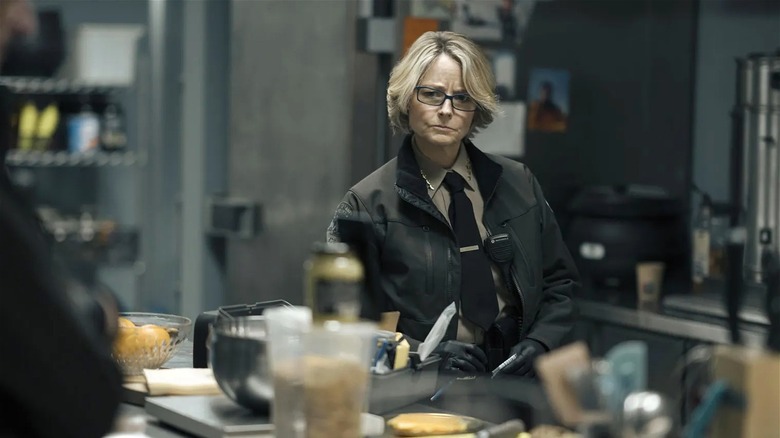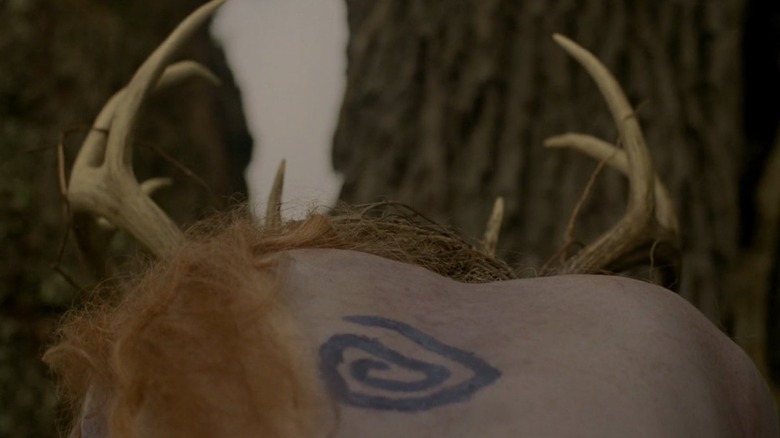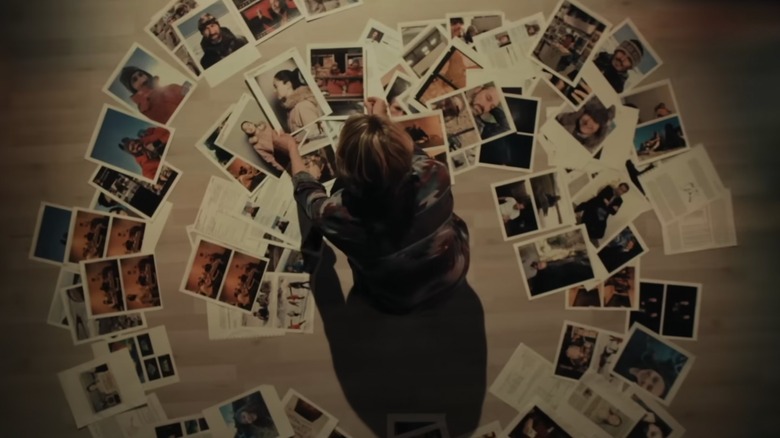True Detective: Night Country's Second Episode Proves That The Spiral Is More Than A Callback
This post contains spoilers for "True Detective: Night Country."
The first time we glimpse the spiral in the first season of "True Detective" is when Detective Rust Cohle (Matthew McConaughey) inspects Dora Lange's corpse, which is propped up in a ritualistic manner. This is not the only time the spiral appears — we see it as a tattoo and as a part of Cohle's vision/hallucination of the shape made up by a flock of birds above an abandoned church. A primary reason why season 1 of the series is so rewatchable can be attributed to its open-ended intrigue, much like a spiral, that does not consume itself like an ouroboros. While there are countless ways to interpret what the spiral truly means, as it is established as a symbol for the depraved Tuttle cult, its symbolism remains one that evokes cyclical loops and inevitability.
"True Detective: Night Country" honors its predecessors in a taut, smart fashion, while situating its premise in a space that feels liminal, namely the fictional mining town of Ennis, where the central mystery unfolds. The spiral was seen in the show's trailers, which, at the time, could have been construed as an Easter egg meant to establish parallels to season 1. However, episode 2 of the show confirms that the spiral is more than just a callback, and could very well be a significant part of the case that Detective Liz Danvers (Jodie Foster) and Evangeline Navarro (Kali Reis) are trying to solve.
Let's look into the possible interpretations of the spiral with regards to season 1, and how "Night Country" uses it to evoke the esoteric and supernatural, granting the Tsalal Arctic base disappearance case an even darker tint.
Spirals and labyrinthine mysteries in True Detective
During one of Cohle's philosophical ramblings, he says, "This is a world where nothing is solved": an alarming reminder that even if a case is officially closed, unanswered questions linger, especially within the context of the Yellow King, who doubles as a literary reference and a symbol emblematic of the evil that the Tuttle cult indulged in. Much like the spiral, some mysteries always remain open-ended, snaking around like a labyrinth whose center offers no real closure or resolution.
While Rust and Marty (Woody Harrelson) catch the perpetrators, we do not have clear answers about who the Yellow King is, or how these symbols weave together to form a grander picture. Cohle challenges this open-endedness with his "time is a flat circle" metaphor, while reluctantly indulging in the idea that the light might eventually seep through the cracks. "Night Country" deliberately destabilizes this tender hope, with its dark, cold setting where light is not only a luxury but an impossibility due to natural cycles that cannot be broken, or challenged. This literal darkness intensifies with the re-emergence of the unsolved Annie K. case, which comes back to haunt every individual in Ennis for better or for worse.
As the spiral evokes themes of looped histories, recurring inevitabilities, and monsters at the heart of a circular maze, it is interesting to liken it to Nietzsche's theory of "Eternal Recurrence" or Return, where he posits a hypothetical situation where every joyful, anguished, painful, or hopeful moment in one's life would play out time and again in an inescapable loop. While Nietzsche's hypothetical query is more of a litmus test for personal integrity, "True Detective" remolds this into an unspoken natural law that leads to cyclical instances of good, evil, and everything in between throughout history.
What the spiral could mean in Night Country
One of the most startling lines of dialogue spoken in episode 2 of "Night Country" is when Rose Aguineau (Fiona Shaw) states that evil might be gripping Ennis because "the world is getting old" and its fabric is coming apart at the seams. When asked about the spiral tattoo found etched on the forehead of one of the frozen researchers, Rose says that the symbol is older than the ice itself, although she is not sure what it exactly means. Although the spiral is not mentioned again in the episode, its presence introduces another layer of mystery about a space plunged into darkness, hiding forgotten secrets in plain sight.
It is crucial to note that Danvers finds out that the researchers were in the process of sequencing an extinct microorganism nestled deep within the ice, which could presumably cure terminal illnesses and aid humanity as a whole. One doesn't have to have watched "The Thing" to deduce that such an undertaking is rife with risks — anything that predates the ice or is buried deep within to the point of extinction, should not be awoken, no matter how noble one's intentions are. Is the world coming apart at the seams because the spiral, which might stand for something primordial that is not meant to be disturbed, is now unraveling?
Another troubling revelation is the resurgence of the Tuttle name, which seems to be financing the Arctic base. Is the Tuttle legacy still alive and well, camouflaged under the guise of industrial development and natural research? This might not be the last we have seen of the spiral, and its true meaning, if revealed, could completely recontextualize our understanding of "Night Country."
Episodes of "True Detective: Night Country" are currently streaming on HBO.


